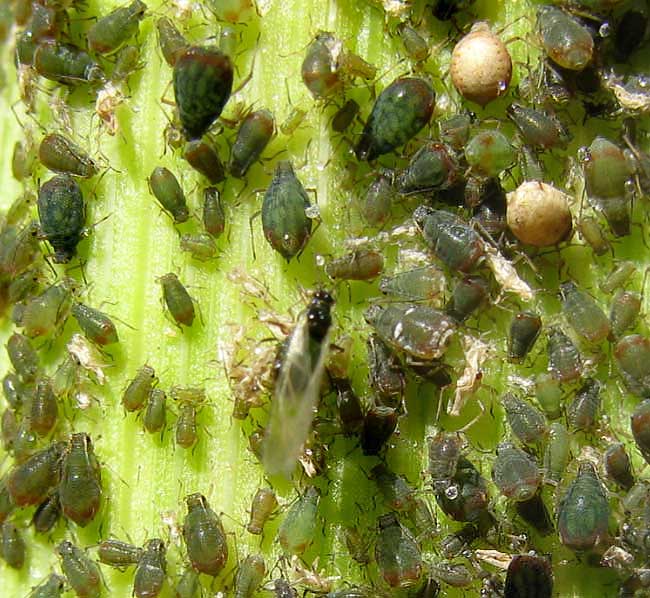


The picture at the right shows a bunch of Turnip Aphids, Lipaphis erysimi, on the bottom of a turnip leaf. Amazingly, this leaf was plucked from my garden and scanned on a cold January morning just two days after the local temperature had dropped to 14° F (-10°C). Obviously these critters can endure some cold weather! The largest aphid in the picture is only about 1/16th of an inch long (2 mm).
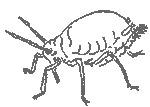 The drawing at the left gives a better idea of what a wingless aphid
looks like. Aphids spend most of their lives with their straw-like beaks stuck into leaves
and stems, sucking out sweet plant juices.
The drawing at the left gives a better idea of what a wingless aphid
looks like. Aphids spend most of their lives with their straw-like beaks stuck into leaves
and stems, sucking out sweet plant juices.
As is so often the case with any type of insect, there are many kinds of aphid. Not only are aphids spread through several genera, there are even entire families of them. There are Woolly and Gall-making Aphids in the family Eriosomatidae, Pine and Spruce Aphids in the family Chermidae, Phylloxeran Aphids in the family Phylloxeridae, and our Turnip Aphids are "typical" aphids in the Aphid Family, the Aphididae, which includes several thousands of species.
Often you see aphids with curious antenna-like projections on their rear ends -- where antennae don't belong -- such as those shown below, their rear ends pointed toward the top of the picture:
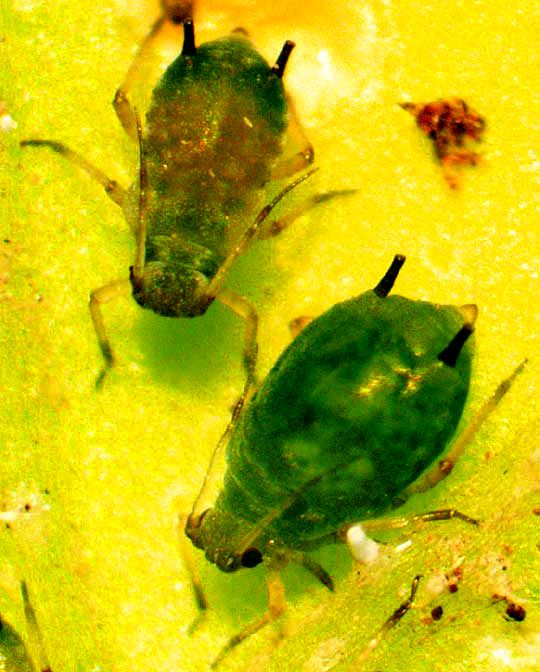
Those rear-end projections are called siphunculi (singular: siphunculus) or sometimes "cornicles," and are one of the defining features of aphids, though some aphid kinds don't have them. Siphunculi have openings at their tips, or "pores," from which chemical pheromones are emitted, pheromones being chemicals that travel by air and affect other individuals of the same species. Pheromones issuing from siphunculi often appear as tiny globules of liquid issuing from the pores. Among insects, often pheromones are thought of as sexual attractants. Also it's been suggested that when siphunculi are particularly conspicuous, as on the above aphids, they may also look like antennae to the aphids' enemies. The enemies would then attack the aphid's rear end believing it to be the head, for a head attack would be more likely to incapacitate prey than one on the rear end. Probably the species in the above picture is a Cotton Aphid, Aphis gossyppi
Each of the many aphid species has its own life cycle, but there are some features uniting nearly all of them. One feature most species share is that they are incredibly prolific. Wingless adult female aphids can produce 50 to 100 offspring. A newly born aphid becomes a reproducing adult within about a week and then can produce up to 5 offspring per day for up to 30 days! The French naturalist Reaumur during the late eighteenth century calculated that if all the descendants of a single aphid survived during the summer and were arranged into a French military formation, four abreast, their line would extend for 27,950 miles, which exceeds the circumference of the earth at the equator!
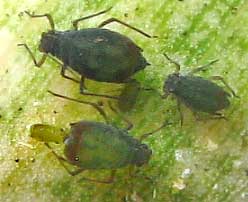 An even more amazing feature of life cycles of most aphid species is that reproduction during at least part of its life cycle can be accomplished without the help of male aphids! Babies have no fathers.Young are born from females without the benefit of sexual reproduction, in a process known technically as parthenogenesis. When mother aphids reproduce parthenogenetically, instead of laying eggs they give birth directly to smaller editions of themselves, which is what the lowest aphid mother is doing in the picture at the right. As the baby aphid was being born it wiggled its legs vigorously. Parthenogenesis occurs in a number of lower animal species.
An even more amazing feature of life cycles of most aphid species is that reproduction during at least part of its life cycle can be accomplished without the help of male aphids! Babies have no fathers.Young are born from females without the benefit of sexual reproduction, in a process known technically as parthenogenesis. When mother aphids reproduce parthenogenetically, instead of laying eggs they give birth directly to smaller editions of themselves, which is what the lowest aphid mother is doing in the picture at the right. As the baby aphid was being born it wiggled its legs vigorously. Parthenogenesis occurs in a number of lower animal species.
Often when you're looking closely at a colony of aphids you see brown, roundish things like those shown below:
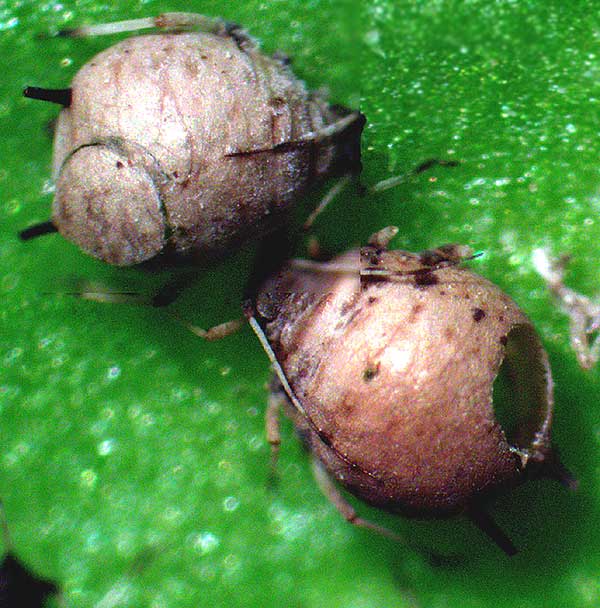
Those are aphid mummies. Notice that one mummy's rear end has a circular hole in it and the other mummy's rear end has a hole with the lid still on it. The story behind all this begins when a tiny wasp inserts an egg into the aphid. In about two days a wasp grub hatches and feeds on the living aphid by osmosis for about six to eight days, killing the aphid. During this time the larva expands in size so that the aphid's body swells, giving it a bloated appearance. 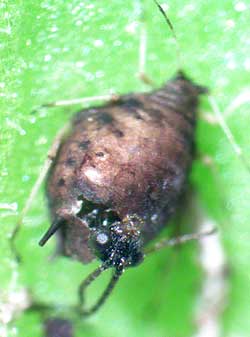 The larva cuts a slit in the bottom of the aphid, and, working from inside the aphid, attaches the dead aphid to the leaf with silk and glue. Then the wasp grub still inside the mummy molts to the pupal stage as the dead aphid turns from green to brown, becoming a "mummy." After four or five days a wasp emerges from the pupa inside the mummy and exists the aphid by cutting a circular hole in the mummy's top. At the right, a black wasp emerges from a mummy's rear end.
The larva cuts a slit in the bottom of the aphid, and, working from inside the aphid, attaches the dead aphid to the leaf with silk and glue. Then the wasp grub still inside the mummy molts to the pupal stage as the dead aphid turns from green to brown, becoming a "mummy." After four or five days a wasp emerges from the pupa inside the mummy and exists the aphid by cutting a circular hole in the mummy's top. At the right, a black wasp emerges from a mummy's rear end.
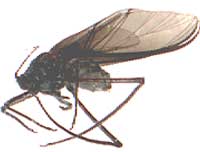 In spring an egg hatches, producing a wingless
female aphid who soon begins parthenogenetically producing new wingless females.
Generation after generation of wingless females survive one another until hot weather
comes or maybe the plant on which they are living dies and then suddenly some of the
females grow wings and fly off. At the left you see what a winged aphid may look like,
though they come in many colors and shapes.
In spring an egg hatches, producing a wingless
female aphid who soon begins parthenogenetically producing new wingless females.
Generation after generation of wingless females survive one another until hot weather
comes or maybe the plant on which they are living dies and then suddenly some of the
females grow wings and fly off. At the left you see what a winged aphid may look like,
though they come in many colors and shapes.
This new generation of female winged aphid very well may at this time find a plant host of a completely different species from that on which their spring generations developed. For instance, Green Peach Aphids overwinter as eggs on peach and related trees but in spring they move to various weeds and agricultural crops, and then still later they move onto potato crops, only in the fall returning to peach and related trees.
Typically late in the year when it's time to move back to the plant species on which the aphid overwinters, finally some aphids develop into males as well as females. Sexual reproduction then takes place and when the mated females return to the winter plant-host they lay fertilized eggs. Then next spring the females hatch from the eggs and the cycle begins again, with no males in sight.
Our Turnip Aphids differ from this scenario a little. Since they live in a part of the country where winters are not so severe, so that an overwintering "egg stage" is not really needed, reproduction throughout the year is often entirely or nearly entirely parthenogenetic.
Though aphids look so plump and dumpy that they could never fly far, in fact they can travel hundreds of miles with the assistance of low-level jet winds.